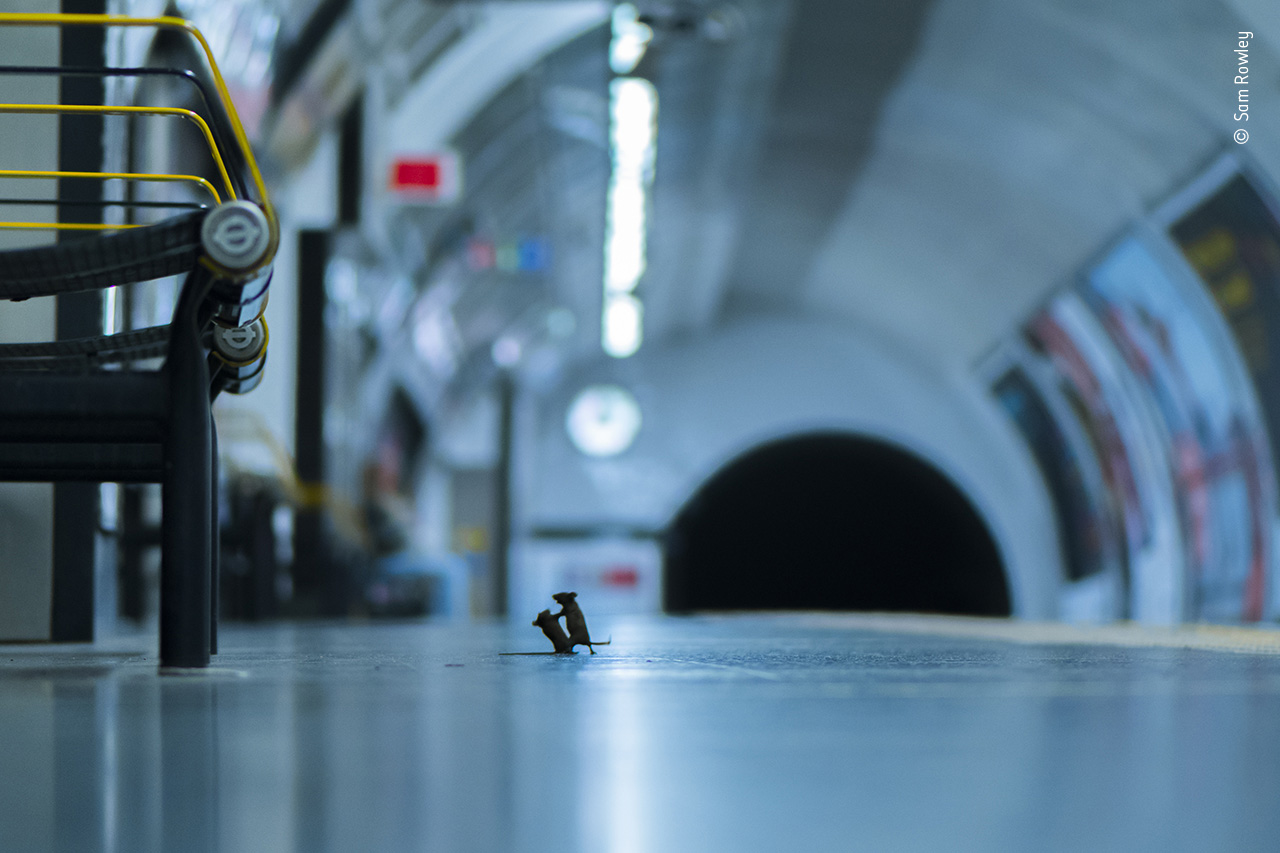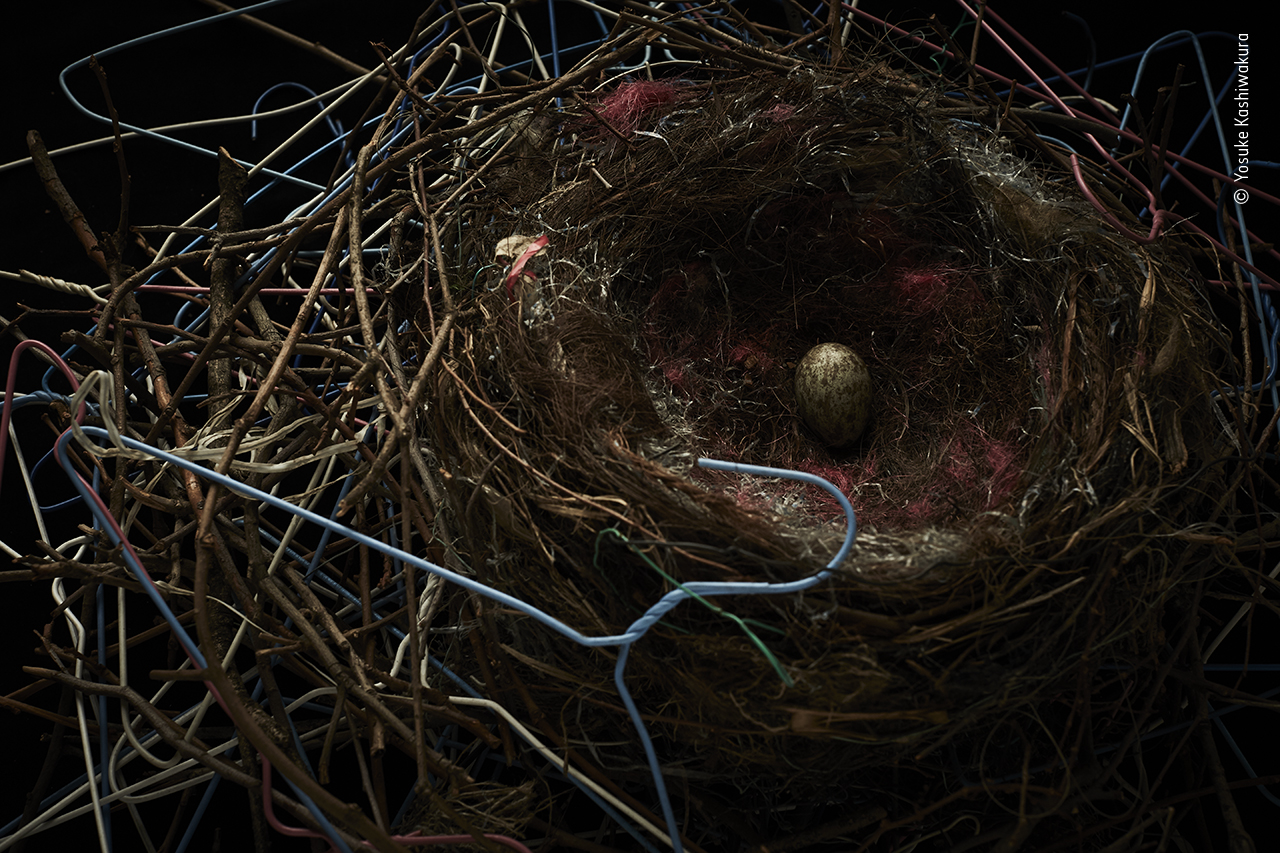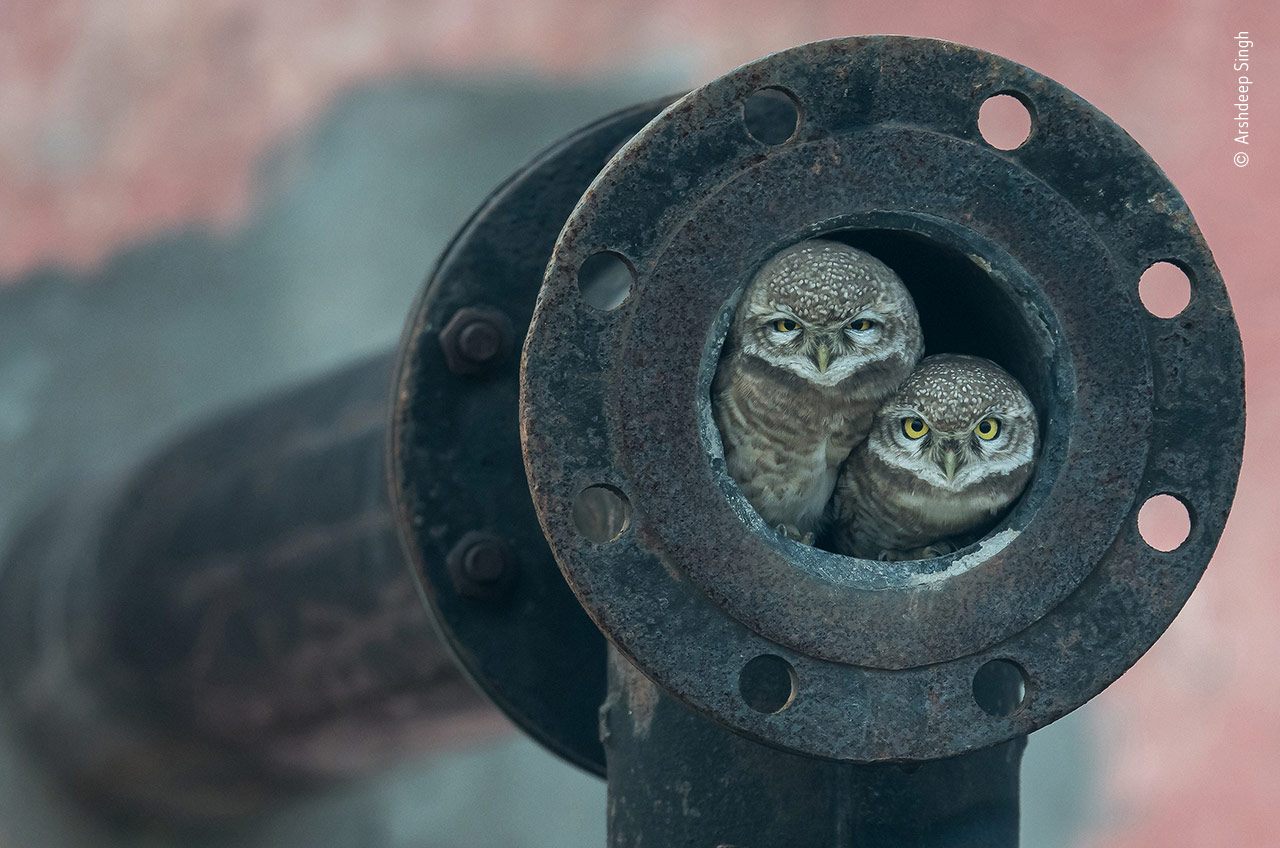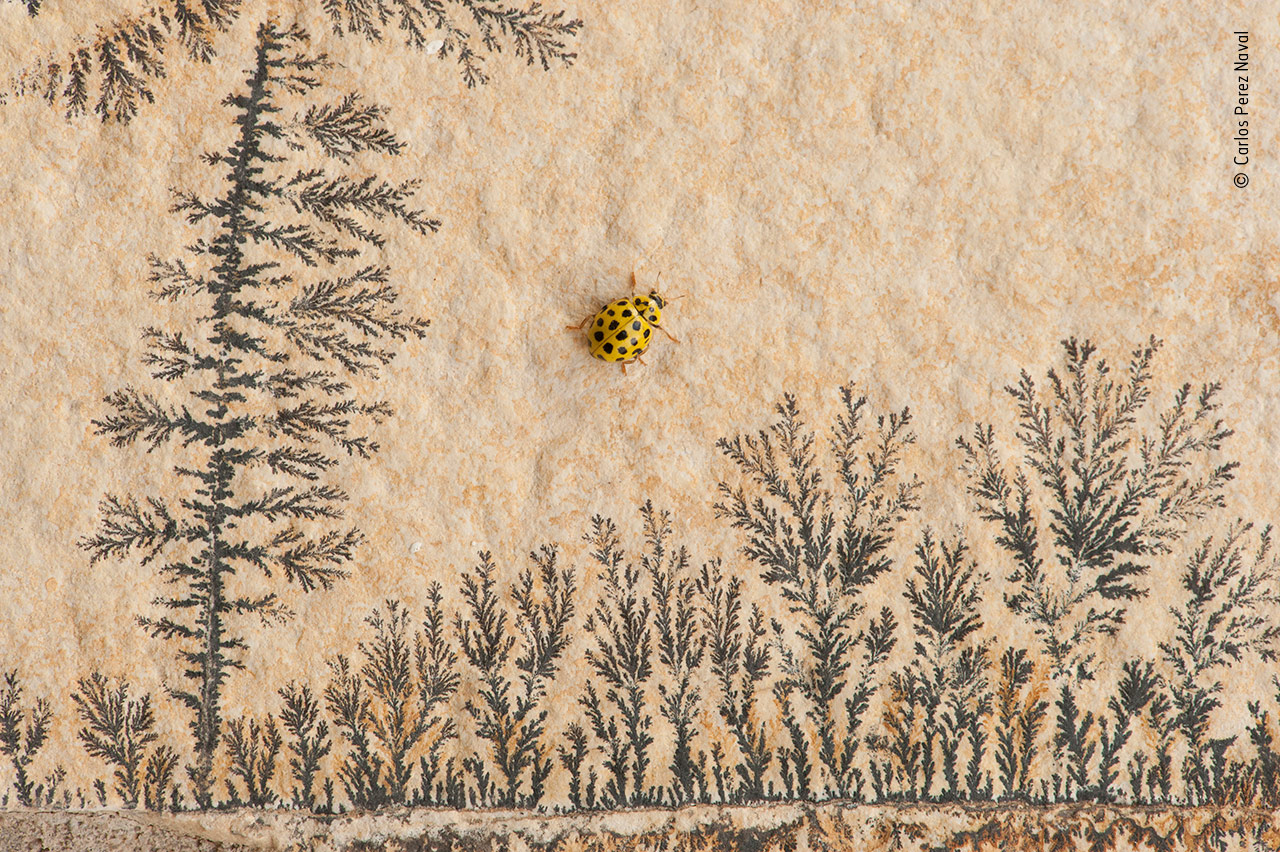
Peeking Possums was Highly Commended in the 2020 Urban Wildlife category © Gary Meredith
undefinedWildlife Photographer of the Year: finding urban wildlife
Alison Groom
Around the world sprawling towns and cities offer homes to millions of people, and while they may look like man-made spaces, there is nature in between the cracks.
Wildlife Photographer of the Year is renowned for its awe-inspiring images of dramatic landscapes, rare species and unique behaviours. In recent years however, photographers around the world have been working closer to home, to document and appreciate the nature that lives right next door.
Whether it is macaques making themselves at home in a discarded sofa, or a gull enjoying the calm waters of London's docks, nature exists in cities and towns, all we have to do is look for it.
City gull - Eve Tucker
In the middle of one of the busiest cities in the world, a black-headed gull rests in the calm waters of London's financial district and docklands.

City Gull won the 2012 15-17 Years category © Eve Tucker
Gulls are common in the city, however the reflection of the surrounding buildings in the water made the scene quite remarkable. The straight lines of the nearby office block appear as stylised curves when reflected by the calm waters of the docks.
Eve noticed this pattern and took out her camera to start shooting. She says, 'The effect was so unusual – it gave a beautiful setting for an urban wildlife image.'
Station squabble – Sam Rowley
Sam's photo of two tiny mice fighting over food scraps on the London Underground went viral after it won the People's Choice Award in 2020.

Station squabble was the winner of the 2019 LUMIX People’s Choice Award © Sam Rowley
Mice are a familiar sight in the underground's network of tunnels, mostly surviving off food and rubbish that is dropped by commuters as they pass through the busy station.
While the constant roar of trains and regular passers by often scared off the mice, Sam notes that 'Urban wildlife is usually more approachable than their countryside cousins, allowing me to get more creative with my approach.'
The Art of Recycling - Yosuke Kashiwakura
The animals that live among us in cities are adaptable creatures and urban birds like crows are known to be opportunistic when it comes to building their nests.

The Art of Recycling was Highly Commended in the 2020 Urban Wildlife category © Yosuke Kashiwakura
Yosuke's photograph shows a crow's nest made up in part by coat hangers which it has scavenged off balconies nearby.
Yosuke had the chance to photograph this nest after it was removed by municipal workers for posing a safety hazard. It is not uncommon for crows to cause blackouts if they build nests like this one near city power cables.
Togetherness - Karen Schuenemann
Clashes between city infrastructure and urban nature can be kept to a minimum through the establishment of inner-city wildlife reserves and sanctuaries.

Togetherness was Highly Commended in the 2018 Behaviour: Birds category © Karen Schuenemann
Karen was on her morning walk in the San Joaquin Wildlife Sanctuary in Irvine, California when she spotted this pair of western grebes rebuilding their nest after it was raided by a racoon.
The pair seem to be mirroring each other as they pass through the water which suggests this household task is also some form of courtship ritual. Western grebes are known for their intricate display rituals.
Cat attack - Stefano Unterthiner
While many animals have adapted to live alongside humans in relative harmony, living alongside other urban animals is a different story.

Cat attack was a finalist in the 2017 Urban Wildlife category © Stefano Unterthiner
Stefano was awoken early one morning by one such clash when a local cat crept too close to a kestrel's nest in the Italian town of Matera.
The birds build their nests in the town's historic stonework, helped along by local people who put out nest boxes. Such intervention is often vital to protect Europe's largest breeding colony of lesser kestrels from the town's curious cats.
Couch Crew – Cyril Ruoso
A group of long-tailed macaques rest on an old sofa, having made themselves at home in a disused temple in Thailand.

Couch Crew was Highly Commended in the 2019 Urban Wildlife category © Cyril Ruoso
Long-tailed macaques are highly adaptable and opportunistic animals which have been able to thrive across many different environments, including living closely with humans.
While close to temples and holy places the animals are tolerated, and sometimes even venerated, within cities they are often considered pests due to the damage that they can cause to farms and property.
Pipe Owls - Arshdeep Singh
In another example of unlikely homemaking, Arshdeep's photo shows a pair of spotted owlets emerging from their nest in a disused wastepipe.

Pipe Owls was the Winner of the 2018 10 Years and Under category © Arshdeep Singh
Spotted owlets would usually nest in tree hollows but widespread deforestation in the area has displaced this breeding pair.
Arshdeep caught sight of this pair when he was driving through the city with his father. He used his father's camera and telephoto lens to take this photo which won the 10 Years and Under category in 2018.
Small World - Carlos Pérez Naval
An important skill for any urban wildlife photographer is the ability to notice the nature that is all around us.

Small World was Highly Commended in 2018's 11-14 Years category © Carlos Pérez Naval
Carlos Pérez Naval spotted this pyrolusite mineral growing on the stone wall of a house near his home in Spain.
This mineral formation occurs when water percolates through the cracks of sedimentary rocks, the repeating pattern leads it to look almost like trees in a forest.
Carlos waited for half an hour until the ladybird wandered over for him to get his perfect image. He believes the photo 'shows the beauty of small and common places when you stop to look closely'.
The Village Cat - Masood Hussain
Masood spotted this lazing leopard, relaxing on the wall of an abandoned school, on his way home from tracking tigers in the nearby forest.

The Village Cat was Highly Commended in the 2020 Urban Wildlife category © Masood Hussain
Leopards are becoming increasingly common in urban areas as they adapt to the human encroachment on their habitat. These resourceful cats have learnt to hunt dogs and livestock, instead of their natural prey, in order to survive in urban spaces.
Despite their adaptability, their numbers are declining. Leopard skins and body parts are traded illegally around the world and so they are at risk from poachers. They have also suffered huge habitat loss in recent years as urban development spreads into their wild homelands.
City Fisher - Felix Heintzenberg
A kingfisher makes the most out of it's man-made environment by using the metal rod at the opening of a sewerage outlet pipe as a handy perch from which to spot fish in the water below.

City Fisher was Highly Commended in the 2018 Urban Wildlife category © Felix Heintzenberg
In this urban area the presence of a kingfisher is a good sign. Kingfishers are considered indicators of good water quality and with increased management of water treatment and pollution, these beautiful birds are slowly making a come-back to our urban spaces.
For better or for worse, we humans live in constant close contact with the natural world. While it helps us in countless ways, our relationship with nature is often far from mutually beneficial.
As the dominant species, we must learn to be neighbourly, and respect the space and livelihoods of the creatures around us. By keeping our air, green spaces and waterways clean, we can welcome nature, and reap the benefits that living in harmony with the natural world can bring.
How can we help urban wildlife?
- Enjoy and care for the green spaces in your urban environment
- Talk to your friends and family about the importance of urban wildlife
- Notice and appreciate the species that live around you. You can contribute observations to many UK recording schemes. Read our guide to Getting started with wildlife monitoring.
Don't miss a thing
Receive email updates about our news, science, exhibitions, events, products, services and fundraising activities. We may occasionally include third-party content from our corporate partners and other museums. We will not share your personal details with these third parties. You must be over the age of 13. Privacy notice.
Follow us on social media